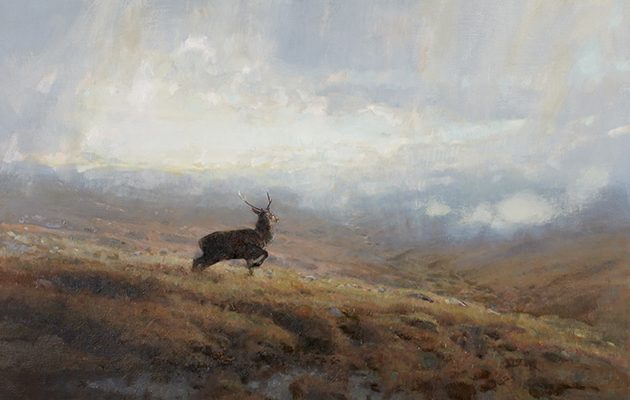A close engagement with his subjects is significant for Ian MacGillivray. As he tells Janet Menzies he finds inspiration in the human relationships with the wilderness he portrays
Ian MacGillivray uses his sporting art to voice the entire journey of stalking. Not just that glimpse of the stag. With fears that sport is being brought to us in a very processed way, telling the story of the whole, often arduous, journey is all the more vital. Janet Menzies finds his art revealing to her exactly what she loves about stalking.
For more sporting artists, Freddy Paske went from active service to sporting art. And Jim Starr takes his inspiration from his love of birds and street art.
IAN MACGILLIVRAY
The signs of sporting artist Ian MacGillivray’s weekly workout are plain to see on the wall of his Cheshire studio. This artist’s equivalent of a set of dumbbells is a series of small, highly atmospheric, studies of an oak tree. It is standing in a field and seen throughout the changing seasons.
He explains: “They are my equivalent of gym work. Much of what I paint as a sporting artist is subject-led. And therefore it is dependent on the open season for whichever sport. That can be quite restrictive. So with this project I can find a way of painting outdoors all year round. It is a bit like training. And you keep your hand and eye in for the bigger paintings. Working from life, as I do, you have to pay attention to these basics. If you don’t do that you are disadvantaged for painting nature. You do have to be out in it.”
COMMITMENT AND AUTHENTICITY
Such commitment gives MacGillivray’s work great authenticity. In his series of hound paintings you can smell the tang of hot hound in cold air and hear the rustle of dead bracken as the pack casts through. A stag looks directly at the painter – and therefore the viewer. Momentarily disturbed by some change of scent, and you can feel the damp clag of the peat. “I want to show that moment,” says Ian MacGillivray. “You know, when you see a stag and you are just getting into it. And then, for whatever reason, its head is up and away it goes. It is one of those things you see out on the hill.
“I do use photographs, and they are a wonderful tool to have. But if you can do a sketch straight away on the hill, that is great. Then I will go back into the studio with it. But eventually a painting has to stand up in its own right and then you arrive at something that works.” This close engagement with his subject is something important to MacGillivray at every level. “I would champion sporting art over other nature and wildlife art because there is so much more to it than just the subject. Much of the presentation of wildlife is almost at arm’s length – literally through a telephoto lens, a kind of armchair view of the wild. But I want to involve you in an authentic experience. That’s highly political really because it is about people and their relationship with nature.
“When you have a genre, as I do with sporting art, obviously you work within that. But equally the painting must have merit as art. It is not enough to pick a subject, you have to believe in it. For me that means thinking about the human element, which is really important to sporting art. It is the stalkers and the keepers who are engrained into the fabric of nature. The people involved in our country sports are linked directly into our history as humans, hunting and living closely with the wilderness.”
THE SURVIVAL OF AUTHENTIC SPORT
Ian MacGillivray worries that the way of sport shown in his painting may not survive. “My fear for the long term is that instead of the holistic approach to sport, say of walking up onto the hill and going through that long, arduous experience, sport is beginning to be brought to us in a very processed way.”
Anyone who has seen the “honeypot” approach to some of the more intensively managed Highland estates will understand his concerns. As an artist, Ian MacGillivray is able to make his contribution to the debate by producing work that is far more than simply decorative. Looking at his paintings of stags, I was strongly aware that what I love about stalking is crawling for hours through peaty burns and shinning up endless scree-covered corries. The glimpse, hopefully within range, of my quarry turns the experience into a full story, but it is the journey that counts.
“The critical thing for me is how that aspect is very often missed,” says MacGillivray. “When we take part in these sports or we paint them, our relationship with our history as humans is still there, intact. When I lived in Inverness, I had the opportunity to get out into the wild places, and I have done so much stalking it has become my primary interest. But now that I live in England I can still go out and find a wild place in the nearest hedgerow.”
See Ian MacGillivray’s work via social media and at www.ianmacgillivray.co.uk





